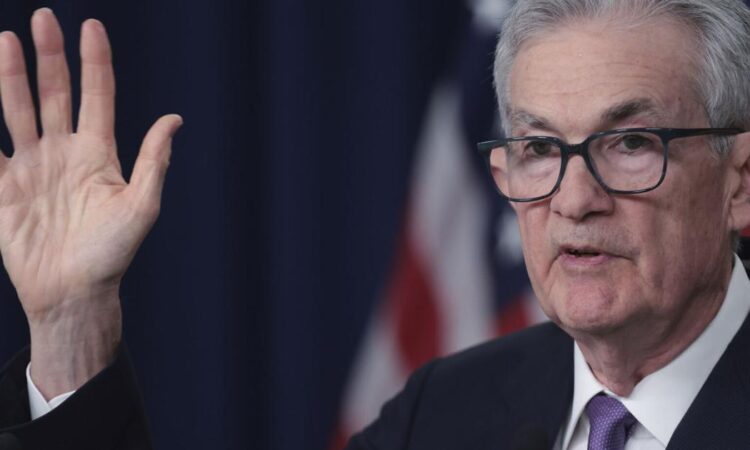
The U.S. economy appears poised for a gentle 2024, with forecasts of declining inflation, interest rate cuts and only a slight uptick in unemployment.
Though the lack of turbulence has pleasantly surprised recession doomsayers as inflation has declined — a trajectory that often inflicts pain in the form of rising unemployment — monetary policymakers have continued the refrain of the future being all but sure.
“Inflation has eased from its highs, and this has come without a significant increase in unemployment. That is very good news,” Fed Chair Jerome Powell said at a Dec. 13 news conference following the Federal Open Market Committee (FOMC) decision to leave interest rates unchanged at its final meeting of the year. “But inflation is still too high, ongoing progress in bringing it down is not assured and the path forward is uncertain.”
The FOMC, which sets monetary policy, last week announced it would leave interest rates at 5.25% to 5.5% for the third consecutive time. The Fed Board and its bank presidents also projected the central bank will make three quarter-point rate cuts in 2024, that unemployment will tick up to 4.1% next year and inflation will fall to 2% by 2026. That’s the agreed-upon level to achieve the Fed’s dual mandate of price stability and maximum employment.
The markets soared in response, reflecting optimism the U.S. economy will come in for a soft landing, in other words, that this period of higher rates will successfully temper inflation without triggering a recession.
“Basically, what the Fed did was make a modestly dovish pivot in 2024” by indicating another rate increase is unlikely, said Scott Anderson, chief U.S. economist and managing director at BMO capital markets. “And the markets are just running with that. It’s almost like the Fed gave them an inch, and the market’s taking a mile here, in terms of the reaction.”
Even before the FOMC meeting, market-watchers were gearing up for good news. Most respondents to the National Association of Business Economics’ December outlook survey put the probability of a recession within the next year at less than 50%, down from the previous year.
But the panel of professional forecasters also cited “too much monetary policy tightness” and conflicts in Ukraine and the Middle East “as the largest downside risks for the U.S. economy.” Economists are also keeping a close eye on China, where slowing growth could have ramifications for the U.S.
“I’m sure there will be some volatility and some ups and downs in 2024, but I’m optimistic for the year,” David Royal, chief financial and investment officer at Thrivent, said at the firm’s latest market and economic update.
The overarching optimism of economists and monetary policymakers might not jibe with the experiences of consumers, who are still grappling with the rising cost of living. Spending has stayed strong but household debt is expanding, increasing $228 billion in the third quarter, according to the New York Fed.
“The financial markets and traders are very good at what they do, but I’m concerned about how much exuberance there has been and how that seems to be very out of touch with how most Americans are feeling about the economy today,” said Tyler Schipper, an associate economics professor at the University of St. Thomas. “And that juxtaposition, I think, worries me, given how much of the driving force in the U.S. economy has been consumers spending despite how they feel about the economy.”
The consumer price index (CPI), which measures the change in prices consumers paid for goods and services, reached a 40-year high of 9.1% in June 2022. The Fed raised interest rates in response, reaching a 22-year high in July.
Inflation has since declined, prompting the Fed to ease off the gas. The CPI increased 3.1% year-over-year in November, down from 3.2% in October and 3.7% in September. Grocery prices are expected to fall in 2024, according to U.S. Department of Agriculture estimates released Thursday that showed a midrange price drop of less than 1%, though the range of estimates also includes the possibility of food prices rising or falling roughly 5%.
Meanwhile, the unemployment rate has remained below 4% for 22 months, a stretch not seen in half a century.
“We have a fantastic labor market, we have rapid disinflation, and we have wages that are starting to pick up and keep pace with inflation again, and this massive wave of worker organizing and strikes and bargaining, and all of those are really great signs for American workers and families,” said Kitty Richards, a former U.S. Treasury official and senior strategic adviser to the nonprofit Groundwork Collaborative.
Richards is hesitant to give credit for declining inflation to the Fed’s interest rate hikes, which she described as a blunt, outdated tool that can inflict more harm than good. She is also critical of the narrative around what caused prices to rise in the first place. The Washington, D.C.-based Groundwork Collaborative has sounded alarms about how corporations took advantage of rising inflation to maximize profits.
“The big story is that the verdict is in on what was causing inflation, and it was not wages, it was not excess demand. It was the unprecedented supply-chain problems that have worked their way out, combined with corporate profiteering,” Richards said. “My hope is that, in the new year, we see some fresh thinking about how to manage the economy in 2024.”







